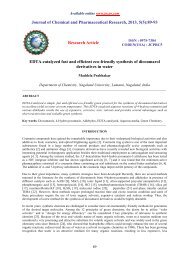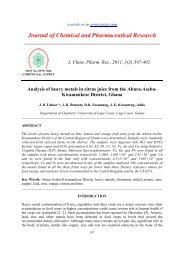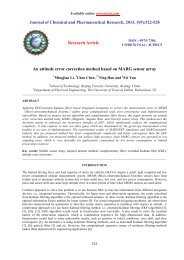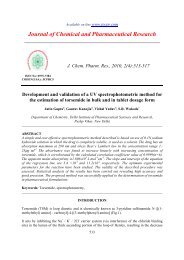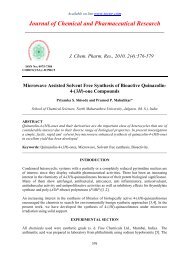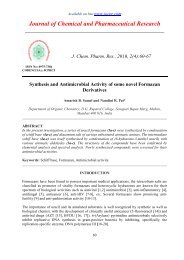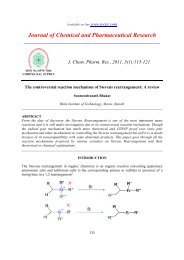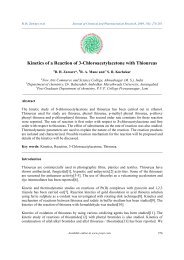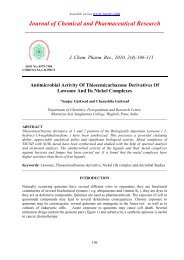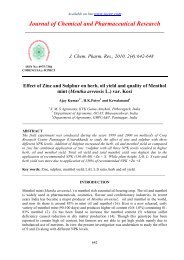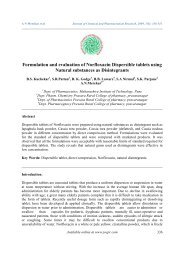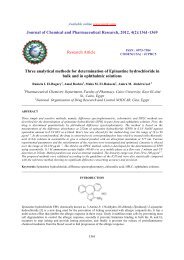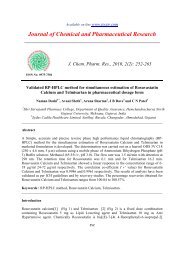Formulation and evaluation of floating drug delivery system
Formulation and evaluation of floating drug delivery system
Formulation and evaluation of floating drug delivery system
Create successful ePaper yourself
Turn your PDF publications into a flip-book with our unique Google optimized e-Paper software.
Available on line www.jocpr.comJournal <strong>of</strong> Chemical <strong>and</strong> Pharmaceutical Research__________________________________________________J. Chem. Pharm. Res., 2010, 2(2): 274-278ISSN No: 0975-7384<strong>Formulation</strong> <strong>and</strong> <strong>evaluation</strong> <strong>of</strong> <strong>floating</strong> <strong>drug</strong> <strong>delivery</strong> <strong>system</strong> <strong>of</strong>Metformin HydrochlorideD. B. Raju, R. Sreenivas <strong>and</strong> M. M. Varma*Shri Vishnu College <strong>of</strong> Pharmacy, Vishnupur, Bhimavaram, India______________________________________________________________________________AbstractSustained release gastroretentive dosage forms enable prolonged <strong>and</strong> continuous input <strong>of</strong> the<strong>drug</strong> to the upper parts <strong>of</strong> gastrointestinal tract <strong>and</strong> improve the bioavailability <strong>of</strong> medicationthat is characterized by narrow absorption window. Gastroretentive <strong>floating</strong> <strong>drug</strong> <strong>delivery</strong><strong>system</strong>s (GFDDS) <strong>of</strong> metformin hydrochloride, an antidiabetic <strong>drug</strong> with an oral bioavailability<strong>of</strong> only 50%(because <strong>of</strong> its poor absorption from lower gastrointestinal tract) have been designed<strong>and</strong> evaluated. Hydroxy propyl methyl cellulose(HPMC K4M) <strong>and</strong> carbopol 934P were used aspolymers <strong>and</strong> sodium bicarbonate as gas generating agent to reduce <strong>floating</strong> lag time.Tabletswere prepared by wet granulation method. Floating tablets were evaluated for hardness,friability, weight variation, <strong>drug</strong> content, <strong>floating</strong> properties <strong>and</strong> in vitro release pattern. The invitro <strong>drug</strong> release followed first order kinetics <strong>and</strong> <strong>drug</strong> release was found to be diffusioncontrolled.Key words: Metformin HCl, Floating <strong>drug</strong> <strong>delivery</strong> <strong>system</strong>, HPMC, Carbopol._____________________________________________________________________________IntroductionDuring the last decade, many studies have been performed concerning the sustained releasedosage forms <strong>of</strong> <strong>drug</strong>s, which have been aimed at the prologation <strong>of</strong> gastric emptying time(GET). The GET has been reported to range from 2 to 6 h, in humans in the fed state(1).Retention <strong>of</strong> <strong>drug</strong> <strong>delivery</strong> <strong>system</strong>s in the stomach prolongs the overall gastrointestinal transittime, thereby resulting in improved bioavailability. Scintigraphic studies determining gastricemptying rates revealed that orally administered controlled release dosage forms are subjected274
M. M. Varma et al J. Chem. Pharm. Res., 2010, 2(2): 274-278_____________________________________________________________________________suitable dilutions were made <strong>and</strong> absorbance was recorded by using Elico U.V.spectrophotometer at 233nm.The experiment was repeated three times.Floating or Buoyancy TestThe time taken for tablet to emerge on the surface <strong>of</strong> the medium is called the <strong>floating</strong> lag time(FLT) or buoyancy lag time (BLT) <strong>and</strong> duration <strong>of</strong> time the dosage form constantly remains onthe surface <strong>of</strong> the medium is called the total <strong>floating</strong> time (TFT).The buoyancy <strong>of</strong> the tablets wasstudied in USP type II dissolution apparatus at 37±0.5 o C in 900ml <strong>of</strong> simulated gastric fluid atpH 1.2.The time <strong>of</strong> duration <strong>of</strong> floatation was observed visually.In Vitro Drug Release StudyIn vitro release studies were carried out by using USP paddle dissolution test apparatus .900ml <strong>of</strong>0.1 N HCl (pH1.2) was taken in the dissolution vessel <strong>and</strong> the temperature <strong>of</strong> the medium wasmaintained at 37±0.5 o C. 100rpm was maintained, 0.5 ml <strong>of</strong> sample was withdrawn atpredetermined time intervals for 12 hours <strong>and</strong> the same volume <strong>of</strong> the fresh medium wasreplaced. The samples were analysed at 233nm by using a UV spectrophotometer( Elico).Thedissolution data obtained were plotted as cumulative percentage <strong>drug</strong> release versus time as zeroorder, log cumulative percentage <strong>drug</strong> retained versus time as first order release kinetics,cumulative percentage <strong>drug</strong> release versus square root <strong>of</strong> time as higuchi equation <strong>and</strong> log <strong>of</strong>fraction <strong>of</strong> <strong>drug</strong> released versus log time as Korsemeyer –peppas equation.Results <strong>and</strong> DiscussionHydrodynamically balanced tablets <strong>of</strong> metformin Hcl (intra gastric buoyant tablets) wereprepared <strong>and</strong> evaluated to increase its local action <strong>and</strong> bioavailability.In the present study fiveformulations with variable concentration <strong>of</strong> polymer were prepared <strong>and</strong> evaluated forphysicochemical properties <strong>and</strong> in vitro <strong>drug</strong> release.On immersion in 0.1 N Hcl solution at pH 1.2 at 37±0.5 o C tablets floats immediately <strong>and</strong> remainbuoyant upto 8-12 hrs without disintegration. Floating property <strong>of</strong> the tablet is governed byboth the swelling (hydration) <strong>of</strong> the polymer when it contacts with the gastric fluid, which in turnresults in increase in the bulk volume, <strong>and</strong> the presence <strong>of</strong> internal voids in the dry centre <strong>of</strong> thetablet(porosity). These two factors are essential for the tablet to acquire bulk density < 1 <strong>and</strong> soremain buoyant on the gastric fluid (5).Hardness <strong>of</strong> the tablets was in the range <strong>of</strong> 4.5 to 7 kg/cm 2 .This ensures good h<strong>and</strong>lingcharacteristics <strong>of</strong> all the batches. Weight loss in the friability test was less than 1% in all thecases, ensuring that the tablets were mechanically stable. All the <strong>floating</strong> tablets preparedcontained the <strong>drug</strong> within 100±5% <strong>of</strong> the label claim. All the formulated tablets (F1 to F5)passed the weight variation test as the % weight variation was within the pharmacopoeial limits<strong>of</strong> ± 5% <strong>of</strong> the average weight.Table2 shows the results <strong>of</strong> buoyancy study. From the results ,it isevident, that formulation F4 containing carbopol 934P showed least <strong>floating</strong> lag time(2min34sec) <strong>and</strong> good total <strong>floating</strong> time >12hrs,while the formulation F5 containing bothcarbopol 934P <strong>and</strong> HPMC K100M showed highest BLT(4min17 sec) <strong>and</strong> total <strong>floating</strong> time <strong>of</strong>>12hrs.This may be due to the different concentrations <strong>of</strong> polymer <strong>and</strong> gas generating agent.Release parameters <strong>of</strong> <strong>floating</strong> tablets are shown in table 3 <strong>and</strong> 4.The formulation F4 was277
M. M. Varma et al J. Chem. Pharm. Res., 2010, 2(2): 274-278_____________________________________________________________________________screened from the above formulations for comparing its in vitro release with the marketedformulation. This is because F4 exhibited least buoyancy lag time 2min.34 sec. Batch F4(carbopol 934P 150 mg, sodium bicarbonate 50 mg) demonstrated good sustained release(Table3). From the in vitro dissolution data it was found that formulation F1 <strong>and</strong> F2 containingHPMC K 100M released 97.2% <strong>and</strong> 95.8% <strong>of</strong> <strong>drug</strong> with in 8 hr <strong>of</strong> study, indicating that thepolymer amount is not sufficient to control the <strong>drug</strong> release. F4 containing carbopol 934P(150mg)alone released 91.23% <strong>of</strong> <strong>drug</strong> at the end <strong>of</strong> 12 hr. Hence, F4 showed better sustained releasethan the other formulations(F1,F2,F3 <strong>and</strong> F5).When the release data was analyzed as per zero <strong>and</strong> first order kinetic models(Table 4),the bestfit with higher correlation (r> 0.9803 )was observed with first order model indicating that the<strong>drug</strong> release from all the batches followed first order kinetics. As the polymer concentration wasincreased, release rate was decreased(6).When the release data were analyzed as per peppasequation, the release exponent n was found in the range <strong>of</strong> 0.56 to 0.67 indicating non-fickian(anomalous) diffusion as the release mechanism from all the tablets prepared. Plots <strong>of</strong> percentreleased versus square root <strong>of</strong> time was found to be linear (r> 0.9804) with all the tablets,indicating that the <strong>drug</strong> release from the tablets was diffusion controlled. Based on cumulative %<strong>drug</strong> released at the end <strong>of</strong> 8hrs, the formulations can be arranged as F1>F2>F4>F3>F5.Metformin Hcl release from <strong>floating</strong> tablet F4 formulated employing 150 mg carbopol 934Pwas similar to that from Gluformin XL-500 mg, a commercial sustained release formulation <strong>of</strong>metformin Hcl.Buoyant <strong>drug</strong> <strong>delivery</strong> <strong>system</strong>s have a bulk density lower than gastric fluids <strong>and</strong> thus remainbuoyant in the stomach for a prolonged period <strong>of</strong> time, without affecting the gastric emptyingrate. While the <strong>system</strong> is <strong>floating</strong> on the gastric contents, the <strong>drug</strong> is released slowly at a desiredrate from the <strong>system</strong>. After the release <strong>of</strong> the <strong>drug</strong>, the residual <strong>system</strong> is emptied from thestomach. This results in an increase in the gastroretentive time <strong>and</strong> a better control <strong>of</strong>fluctuations in the plasma <strong>drug</strong> concentrations.ConclusionRelease <strong>of</strong> metformin HCl from the <strong>floating</strong> tablets formulated with HPMC <strong>and</strong> /carbopol wasslow <strong>and</strong> spread over 12 h <strong>and</strong> depended on % <strong>of</strong> polymer in the tablet. Release was diffusioncontrolled <strong>and</strong> followed first order kinetics. All the formulated <strong>floating</strong> tablets exhibited nonficki<strong>and</strong>iffusion as the <strong>drug</strong> release mechanism. <strong>Formulation</strong> F4 showed better sustained releasethan the other formulations.References[1] P Tayade, Express Pharma Pulse 2003; 14: 1-4.[2] PV Swamy, UV Bhosale, SN Hiremath, SB Shirs<strong>and</strong>, SA Raju, Indian Drugs 2008; 45; 293-300.[3] AK Hilton, PB Deasy, Int. J Pharm. 1992; 86: 79-88.[4] R Garg , GD Gupta, Asian Journal <strong>of</strong> Pharmaceutics, 2007; 1; 219-222.[5] KPR Chowdary, MN Murali Krishna, International Journal <strong>of</strong> Pharmaceutical Sciences <strong>and</strong>Nanotechnology, 2008; 1: 167-170.278



